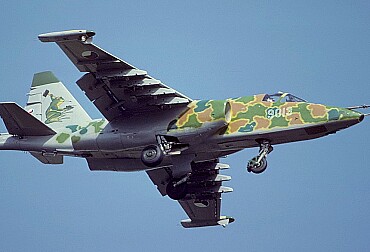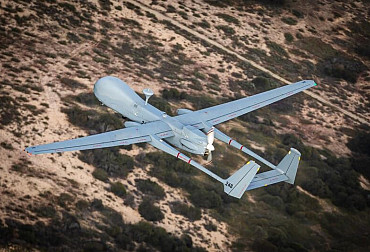Fulcrum: the mighty light frontline fighter, from the MiG-29 to the MiG-35
The MiG-29, or Fulcrum, as it is known in NATO, is a supersonic Soviet/Russian fighter aircraft. It was developed in the Soviet Union between 1970 and 1980 by the Mikoyan-Gurevitch MiG design bureau. The first flight took place on 6 October 1977. The MiG-29 entered service in July 1983. A huge commercial success, particularly in the countries that were part of the Communist bloc at the time, over 1,700 examples were produced (including over 500 in Russia, formerly the USSR, alone). Several versions of this fighter exist and vary according to the demands of the purchaser states. It is currently still in service with various air forces and should not leave the skies before 2035 (including MiG-29 and upgraded versions).
The MiG-29 has proved successful worldwide, with operators beyond the Soviet Union/Russia including Algeria, Azerbaijan, Bangladesh, Belarus, Bulgaria, Cuba, Czechoslovakia and later the Czech and the Slovak Republics, Eritrea, Hungary, India, Iran, Kazakhstan, Malaysia, Myanmar, Peru, North Korea, Poland, Serbia, Sudan, Syria, Turkmenistan, Ukraine, Uzbekistan and Yemen. The East German MiG-29s were eventually sold to Poland. Iraq no longer uses the Fulcrum, while Romania has since withdrawn its small fleet. Israel bought at least one for training aggressors, given that its strongest adversary in the region would have been Russian-made MiG-29s. Yugoslavia is a former operator and these aircraft subsequently fell into Serbian hands during the Serbo-Croat war.
.jpg)
At the beginning of 2011, Russia held some 445 MiG-29s in its inventory, though the actual number is estimated to be around 250 units. India operates several dozen MiG-29s for its air force and navy, making it one of the main export operators of the aircraft. North Korea operates at least 40 Fulcrums, purchased from both Russia and Belarus. In 1997, the US bought 21 Fulcrums from Moldova to prevent these Russian fighters from falling into the wrong hands, giving US engineers unprecedented access to this excellent fighter. Several of these MiG-29s were subsequently exhibited in American museums. Although an excellent combat platform that has proved its worth over the years, the MiG-29 has had its share of high-profile accidents, some of which have resulted in fatalities. Nevertheless, its current power is nowhere near what it was originally, and the programmes have made the most of its basic design.
In 1991, the political climate in Europe saw the end of the Cold War, essentially ending Soviet domination of the region and the Soviet empire itself. Russia entered a period of uncertainty and defence funding was significantly reduced from what it had been during the 'glory days' of the Cold War. As a result, MiG-29 production slowed to a near standstill. German reunification gave Western observers full access to East German MiG-29s for detailed examination.
Development of the MiG-29
At the end of the 1960s, the Soviet Union launched the fourth-generation fighter development programme. This programme was a response to the development of the future American F-15 Eagle fighter by McDonnell Douglas and the P-530 Cobra (which would become the YF-17). The programme was split into two projects: TPFI, (Tyazholyi Perspektivnyy Frontovoy Istrebitel) – heavy future frontline fighter, the Su-27, and LPFI (Lyogkiy Perspektivnyy Frontovoy Istrebitel) – future light frontline fighter, the MiG-29. The LPFI project was entrusted to MiG. The initial project, based on the aerodynamics of the MiG-25 and the weapon system derived from the MiG-23, presented at the beginning of 1972, was not retained.
The technical drawing was presented in August 1972. The first model was assembled in 1976, with the test campaign taking place between 1977 and 1983. The prototype and eight production models took part in the test campaign. Series production began in 1982. On 30 June 1983, the 4th Training and Combat Centre in Lipetsk took delivery of the 1st production MiG-29.
Capabilities of the MiG-29
The MiG-29 is a small aircraft, but it displays excellent technical capabilities, to the point of worrying the Western military for many years. It has excellent manoeuvrability and can maintain a high angle of attack at high flight speeds. It is powered by two Kilmov RD-33 turbojet engines, giving the Fulcrum a maximum speed of around Mach 2.2 (2,400 km/h). However, Russian engines are notoriously energy-hungry, significantly reducing the aircraft's range. The MiG-29's airframe enables it to make high-load-factor turns and perform Pugachev's famous Cobra manoeuvre during an air engagement.
Primarily intended for homeland defence, it was the first aircraft to be equipped with a radar capable of detecting and engaging downward-looking targets. Capable of carrying up to six payloads, the MiG-29 is mainly equipped with the formidable Vympel R-77 long-range air-to-air missile and a 30mm GSh-30-1 cannon with a 150-round capacity.
Main variants of the MiG-29
The MiG-29 has also a two-seat conversion training variant, designated as the 'MiG-29UB', which first flew on 28 April 1981. The main obvious difference of this model was its tandem two-seat cockpit with its rear-hinged canopy. To make room for the second cockpit, the production model's fire control radar was omitted, but for the most part the MiG-29UB remained true and fully combat-capable and, as such, could be relatively easily converted back to its combat form if required. Without the radar, however, student pilots could only train for air-to-air missions. The identification of this model within NATO earned it the nickname 'Fulcrum-B'.
The MiG-29, Product 9.12A and Product 9.12B, also known to NATO as 'Fulcrum-A, was produced between 1988 and 1991. While most of the components remained faithful to the Soviet production mount, they were, on the whole, downgraded to keep the latest Soviet technology intact. The export version A was delivered to certain Warsaw Pact nations, the B for the non-Warsaw Pact users.
Another version is the MiG-29 Tactical Fighter, known in NATO nomenclature as 'Fulcrum-C'. These types are distinguished by the bulge in the fuselage spine, designed to accommodate additional fuel to improve operational range, and a new suite of electronic countermeasures. Production of three prototypes began in 1986 and continued until 1991.
Fulcrum-C's next major development (keeping the NATO codename Fulcrum-C) is the MiG-29S Tactical Fighter. It combines the all-new Vympel R-77 (AA-12 'Adder') radar-guided and active homing air-to-air missile with a Phazotron N019M radar system. This system enables the Fulcrum pilot to release two missiles and have the radar guide each missile to two targets simultaneously. The maximum take-off weight has been further increased to broaden the range of ammunition options. The flight control system has been improved, as has the operational range, with three anchor points linked to external fuel tanks. The MiG-29S became the new Soviet Fulcrum standard in the early 1990s, to which the previous Fulcrum-A and Fulcrum-C production models were upgraded. The MIG-29S became an export product under the designation MiG-29SD. It was considerably improved on the initial export version and production began in 1995.
The MiG-29M designation marked a major upgrade initiative for the Fulcrum line. The final product was a 'Generation 4.5' jet fighter that exceeded the range and capabilities of the original MiG-29 production fighter. The MiG-29M was a multi-role airframe and was equipped with improved avionics and internal systems. The airframe was improved (revised air intakes, increased use of lighter composite materials). An analogue fly-by-wire system was introduced to improve handling. The cockpit has been raised to improve pilot visibility, and stronger landing gear legs have increased the maximum take-off weight. The HOTAS (Hands-On Throttle and Stick) system has also been integrated, giving the pilot more control. An optional laser designator now enables the MiG-29M to designate its own targets, without having to rely on ground forces or other allied aircraft to 'fool' a target when using so-called 'smart' guided munitions. The initial MiG-29M prototype flew on 25 April 1986. The MiG-29M and MiG-29ME, or MiG-33, are known to NATO as 'Fulcrum-E.'
The MiG-35 or 'Fulcrum-F'
The MiG-35, 'Fulcrum-F' in NATO designation, is a Russian fighter aircraft. It was developed between 2000 and 2010. The first flight took place on 24 November 2016 and the type entered service in 2019. The MiG-35 is a generation 4++ fighter. It is a thorough modernisation of the MiG-29M/M2 and MiG-29K/KUB fighters. The first prototype was built on the basis of the MiG-29M2 in January 2007. Design work was completed in October 2016, with the first flight on 24 November 2016 and the start of flight tests on 26 January 2017. The MiG-35 receives the Zhuk-A active-matrix radar, electronic warfare systems, open avionics, an integrated designation system, radar visibility reduction and electronic control of its RD-33MK engines.
The MiG-35 incorporates a wide range of air-to-air and air-to-ground weapons. It can be deployed on summarily prepared airfields. The MiG-35 can be used as an air-to-air refuelling aircraft. In 2018, the Russian Ministry of Defence ordered six examples of the MiG-35, which were delivered in 2019. No more than 6 actually exist within the Russian Air Force inventory.








